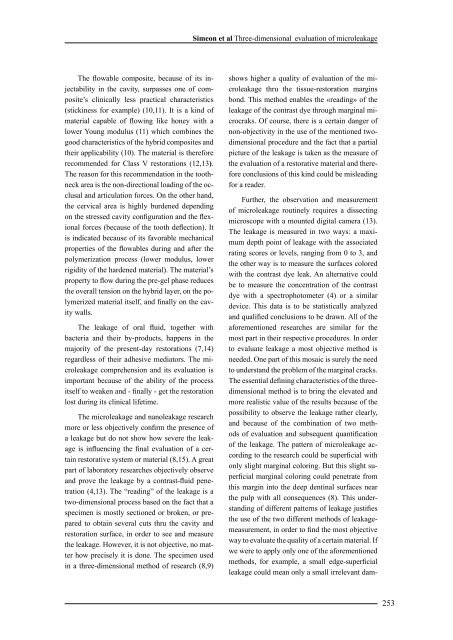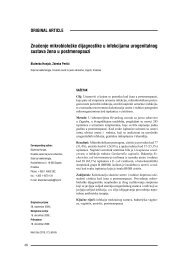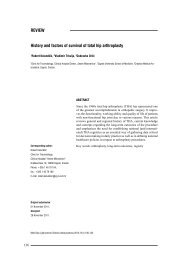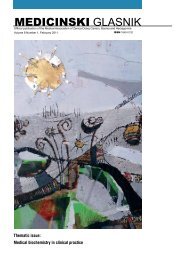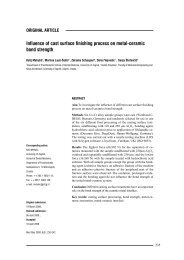MEDICINSKI GLASNIK
MEDICINSKI GLASNIK
MEDICINSKI GLASNIK
You also want an ePaper? Increase the reach of your titles
YUMPU automatically turns print PDFs into web optimized ePapers that Google loves.
The flowable composite, because of its injectability<br />
in the cavity, surpasses one of composite’s<br />
clinically less practical characteristics<br />
(stickiness for example) (10,11). It is a kind of<br />
material capable of flowing like honey with a<br />
lower Young modulus (11) which combines the<br />
good characteristics of the hybrid composites and<br />
their applicability (10). The material is therefore<br />
recommended for Class V restorations (12,13).<br />
The reason for this recommendation in the toothneck<br />
area is the non-directional loading of the occlusal<br />
and articulation forces. On the other hand,<br />
the cervical area is highly burdened depending<br />
on the stressed cavity configuration and the flexional<br />
forces (because of the tooth deflection). It<br />
is indicated because of its favorable mechanical<br />
properties of the flowables during and after the<br />
polymerization process (lower modulus, lower<br />
rigidity of the hardened material). The material’s<br />
property to flow during the pre-gel phase reduces<br />
the overall tension on the hybrid layer, on the polymerized<br />
material itself, and finally on the cavity<br />
walls.<br />
The leakage of oral fluid, together with<br />
bacteria and their by-products, happens in the<br />
majority of the present-day restorations (7,14)<br />
regardless of their adhesive mediators. The microleakage<br />
comprehension and its evaluation is<br />
important because of the ability of the process<br />
itself to weaken and - finally - get the restoration<br />
lost during its clinical lifetime.<br />
The microleakage and nanoleakage research<br />
more or less objectively confirm the presence of<br />
a leakage but do not show how severe the leakage<br />
is influencing the final evaluation of a certain<br />
restorative system or material (8,15). A great<br />
part of laboratory researches objectively observe<br />
and prove the leakage by a contrast-fluid penetration<br />
(4,13). The “reading” of the leakage is a<br />
two-dimensional process based on the fact that a<br />
specimen is mostly sectioned or broken, or prepared<br />
to obtain several cuts thru the cavity and<br />
restoration surface, in order to see and measure<br />
the leakage. However, it is not objective, no matter<br />
how precisely it is done. The specimen used<br />
in a three-dimensional method of research (8,9)<br />
Simeon et al Three-dimensional evaluation of microleakage<br />
shows higher a quality of evaluation of the microleakage<br />
thru the tissue-restoration margins<br />
bond. This method enables the «reading» of the<br />
leakage of the contrast dye through marginal microcraks.<br />
Of course, there is a certain danger of<br />
non-objectivity in the use of the mentioned twodimensional<br />
procedure and the fact that a partial<br />
picture of the leakage is taken as the measure of<br />
the evaluation of a restorative material and therefore<br />
conclusions of this kind could be misleading<br />
for a reader.<br />
Further, the observation and measurement<br />
of microleakage routinely requires a dissecting<br />
microscope with a mounted digital camera (13).<br />
The leakage is measured in two ways: a maximum<br />
depth point of leakage with the associated<br />
rating scores or levels, ranging from 0 to 3, and<br />
the other way is to measure the surfaces colored<br />
with the contrast dye leak. An alternative could<br />
be to measure the concentration of the contrast<br />
dye with a spectrophotometer (4) or a similar<br />
device. This data is to be statistically analyzed<br />
and qualified conclusions to be drawn. All of the<br />
aforementioned researches are similar for the<br />
most part in their respective procedures. In order<br />
to evaluate leakage a most objective method is<br />
needed. One part of this mosaic is surely the need<br />
to understand the problem of the marginal cracks.<br />
The essential defining characteristics of the threedimensional<br />
method is to bring the elevated and<br />
more realistic value of the results because of the<br />
possibility to observe the leakage rather clearly,<br />
and because of the combination of two methods<br />
of evaluation and subsequent quantification<br />
of the leakage. The pattern of microleakage according<br />
to the research could be superficial with<br />
only slight marginal coloring. But this slight superficial<br />
marginal coloring could penetrate from<br />
this margin into the deep dentinal surfaces near<br />
the pulp with all consequences (8). This understanding<br />
of different patterns of leakage justifies<br />
the use of the two different methods of leakagemeasurement,<br />
in order to find the most objective<br />
way to evaluate the quality of a certain material. If<br />
we were to apply only one of the aforementioned<br />
methods, for example, a small edge-superficial<br />
leakage could mean only a small irrelevant dam-<br />
253


